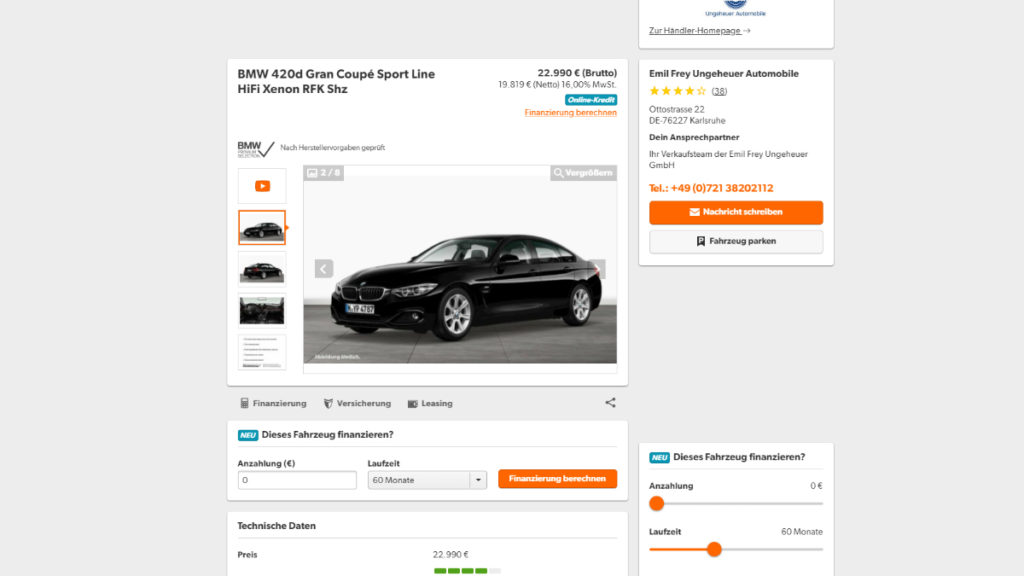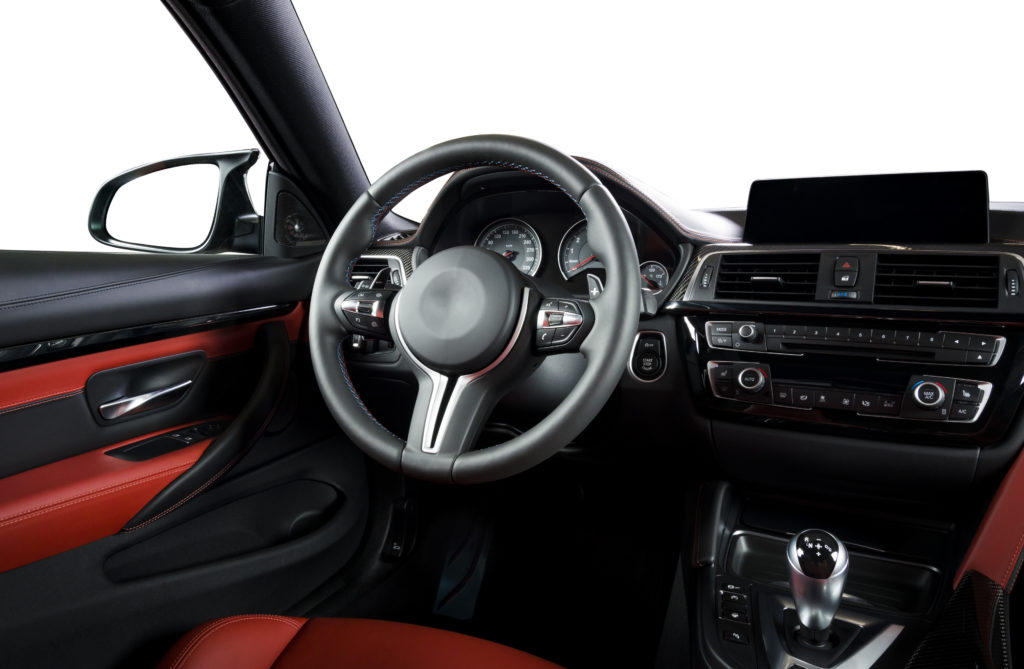In today's fast and digital car trade, one thing is clear: data is the key to success. Every customer who enters your dealership, sees your online advertisements or
-
Torben Ullmann
What does a good online advertisement on a vehicle exchange look like? What is important?
Dealers who sell for their car dealership on an online platform or have set up such a portal themselves know it: potential buyers first look at the photos of the motor vehicles. It is important not to do anything wrong here. After all, more than seven million used cars change hands in Germany every year. So there is a lot of competition, which is why the pictures should be professional. This is not expensive, it usually costs less than ten euros per car. The offer might then be looked at by a few million interested parties.
Reach of the platforms
As mentioned before, there are two ways to offer a vehicle online:
- #1: The car dealership presents itself on the web with its range of new and used cars. The service and the staff can also be presented very well.
- #2: The dealer uses one of the big portals like Autoscout24 or mobile.de. Here the reach is enormous, but so is the competition.
Many commercial car dealers use both possibilities in parallel for each vehicle. So it can happen that a car is discovered by the prospective buyer simultaneously on Autoscout, mobile.de, the dealer's own website and perhaps another portal (or in the newspaper).
That doesn't matter, the interested parties are used to it. Vehicle dealers should never do without the big portals, because their reach is extremely impressive. On mobile.de, for example, around twelve million visitors look at the vehicles every month, on Autoscout24 it is over seven million. These are private and commercial interested parties (from completely different trades, such as craftsmen), but also buyers from other vehicle dealers from all over Germany.
Among other reasons, these can sometimes find a bargain because the vehicle prices for one and the same car differ significantly in different regions of Germany. On average, used cars are most expensive in Bitterfeld-Wolfen (Saxony-Anhalt) and cheapest in Völklingen (Saarland). But there are also differences in individual vehicle brands, which are more in demand in some regions and therefore more expensive than in others.
In a nutshell: cars are traded briskly, prospective buyers click through the offers at lightning speed. They linger on the most beautiful photo first. An offer without a photo is not even looked at by almost 90 % of all interested parties.
By the way, in addition to the two top dogs mentioned above, there are also a number of smaller car portals that should not go unmentioned. These include juhu.auto, pkw.de, hey.car and 12gebrauchtwagen.de. Cars are also offered on eBay and even Facebook. However, you cannot get around mobile.de and Autoscout24: Use these two platforms.

The right presentation of vehicles is decisive
The large platforms such as the two market leaders mentioned above offer private advertisers and traders numerous functions, which in turn are very useful for the end users. The ads can be created with practical tools and then filtered and analysed by the interested party. In addition to 360° photos, videos can now also be posted, the vehicles are classified by the platform in terms of price, and their environmental friendliness can also be seen at a glance. Admittedly, the competition is enormous, because on the two largest platforms mentioned above, about one million sales ads can be found at any time. The presentation must therefore be very professional on the part of a dealer (and also private advertisers).
What do traders pay for the commercial offers?
The platforms distinguish between private and commercial advertisers. For the latter - i.e. car dealers - they offer different prices and packages, which start at around 30 euros per ad at mobile.de. The dealer account costs extra, based on the number of advertisements. The lower price limit starts at around 60 euros per month. Autoscout24 staggers the prices a little differently, here two advertisements cost from 39 euros. If a vehicle dealer places a lot of advertisements and thus achieves a high sales volume, the price can drop to less than ten euros per vehicle.
What does a good online ad look like?
First of all, it has to be found. Then it should draw the potential buyer's attention away from the price and towards the vehicle. Buying a car is something extremely emotional. In the car dealership, the salespeople let the prospective buyer get into the vehicle, where he can touch and smell the car. On the online platform, the prospective buyer only has pictures or videos, which is why they matter. By the way, they must not only be beautiful, but also very informative.
Prospective buyers don't like surprises and therefore don't like open questions. For this reason, good sellers post a lot of photos (usually 12 to 20) so that the car can be seen from the outside and inside from every perspective. Defects should also not be concealed. Pointing them out in a photo makes a serious impression and also justifies a relatively low price compared to the make, model, year of manufacture, mileage and equipment, which would otherwise generate mistrust.
There is explicitly nothing wrong with showing a scratch on the mudguard in a photo. Why not? Well, there are buyers who don't mind precisely this scuff because it lowers the price. These are sometimes very experienced car drivers for whom the vehicle is not a status symbol but a purely utilitarian object. They are looking for a low price in relation to the mileage and year of manufacture, which can really only be justified by cosmetic weaknesses. They are specifically looking for the scuff on the mudguard to save a few 100 euros (sometimes even considerably more). What counts when presenting a vehicle is honesty, a comprehensive visual presentation + informative description and a really reasonable price to go with it.
What do perfect photos look like?
Even if you are not allowed to conceal anything, you should of course present the car as favourably as possible. The following principles apply to a good photo:
- The car must be absolutely clean. This also includes the rims, for example.
- The surroundings must be friendly. A green corner is well suited. For indoor pictures, the environment must be bright and spacious.
- Lighting plays a major role. Very bright daylight or even sunlight is not necessarily recommended because it leads to reflections on the lacquer. These should be strictly avoided.
- The best pictures are taken with a tripod.
- A good camera ensures high quality pictures. Smartphones today also have good cameras, but check in advance. There are also tripods for smartphones.
- The right camera perspective is eye level. This is how a person sees the car in reality. However, the most optimal and beautiful camera perspective is chest height. Use both perspectives.
- Those who dare can take driving snapshots.
- The colour of the vehicle reacts to different light. The principle applies: with darker paint, the light may be somewhat brighter - and vice versa.
- Details are welcome. These include body shapes and lines, the manufacturer's logo, wheel structures and the radiator grille. Inside, it's the cockpit and dashboard in detail (including mileage), the clean seats and the nice big boot.
Good pictures create clarity, bad pictures sow doubt. Only use your own pictures (none from the manufacturer) a) for the sake of truth and b) because of copyright. Leave out mounted attachments and accessories or photograph them separately (child seats, mobile phone holder, roof rack). Also, avoid clear indications of the season when the picture was taken, i.e. do not take a picture in the snow. A price for the car does not belong on the photo at all.

Posting the images on the sales platform
When listing, proceed logically: First offer the viewer a tour around the car (four or more pictures), then show the manufacturer's logo and, if necessary, details such as a small scuff on the wing, and then invite the prospective buyer into the interior. This sequence would also correspond to a real viewing. Finally, optimise the key image that the sales platform shows in the search results: This should show the entire vehicle diagonally from the front.
Any more questions? Would you like more information? We look forward to hearing from you.
Feel free to contact us today to discuss your challenges and to learn more about whether Automanager is the right tool for you.
Our tip
On trend
Recommended articles
Social media platforms are leading the way: Our purchasing decisions are increasingly influenced by visual stimuli. Of course, this also applies to the car trade. Today's car buyers demand
Digitalization has long since found its way into the car trade and is having a lasting impact on the industry. But where do we currently stand? At the moment, the industry is
Digital transformation is not just a buzzword, but is now common practice in many German car dealerships, e.g. in the form of apps for your employees. From the
Vehicle management in the car dealership of the 21st century is a challenge for many car dealers. Between the sharing economy and online platforms, the traditional car dealership is faced with the task of managing its